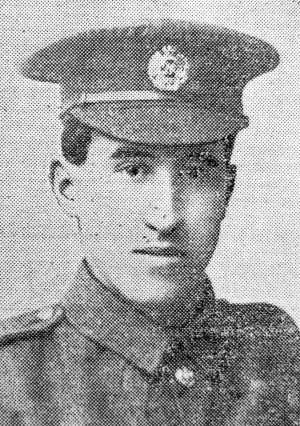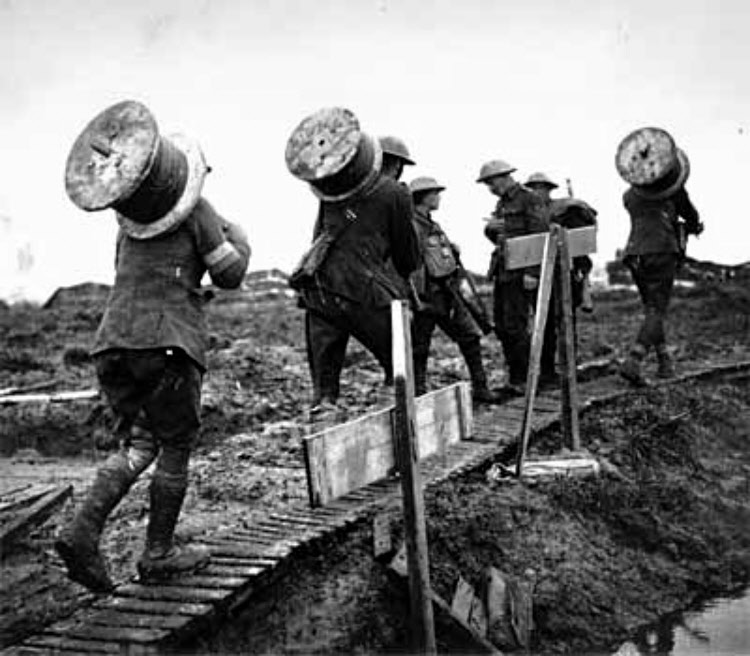
73922, Royal Engineers, B. L. Cable Section
Charles Leonard Whitehead was born in Ossett in early 1894, the son of William Whitehead and Rose Emma (nee Bramley) who married in Harrogate in early 1885. In 1901, the family were living on Bank Street where William Whitehead worked as a joiner and undertaker. Charles, aged 8, has a brother George, aged 19 and a sister Dorothy aged 2.
In 1911 the family have moved to ‘Beechwood’, Prospect Road, Ossett and Charles, aged 18, is employed as a postal clerk in the Civil Service. His father continues his Joinery and undertaking business which also employs Charles’ elder brother George Clifford Whitehead. Their sister, Dorothy is still going to school.
BL Cable Section of RE and was a team of sappers whose responsibility was laying signalling cables between the front-line and Battalion HQ for communications. Usually, they had a horse-drawn cable drum carriage and the team went along laying out signalling cable along hedges and roads, making them extremely vulnerable to enemy artillery or machine gun fire.
Charles Whitehead could have been a driver in the lead team, which consisted of four horses ridden by two drivers, each with a team of two horses. Alternatively, he could have worked as an individual, mounted linesman, riding about ten yards behind the cable-wagon, equipped with a crook-stick that guided the signal cable to avoid obstacles or possibly an individual, mounted linesman who dismounted when required to make the cable ‘safe’, by placing it along, or on the top of hedges etc., or burying it at cross-roads and suchlike.
The “Ossett Observer” 1 carried this report of Sapper Whitehead’s death:
“Charles Leonard Whitehead, aged 23, died in military hospital on 30th July 1916 during fighting at the northern part of the Somme front. He was the youngest son of Mr. and Mrs. William and Rose Emma Whitehead, of Beechwood House, Prospect Road. Charles had enlisted in October 1915, and at the time of his death was a sapper in the Royal Engineers BL Cable Section. Before joining the army he had been a telegraphist and sorting clerk at Dewsbury Post Office, where he was held in high esteem and was described as a reliable worker.
He had only been in France about six weeks before he died. Charles’ parents had received a field postcard, dated 29th July 1916, stating that their son had been admitted to hospital after being wounded. This must have been a very worrying time for them, as little information had been passed to them. During the following week however, they then received a letter from his superior officer, informing them the Charles had received a serious stomach wound as a result of shell fire. The officer went on to say that he had taken him to a dressing station, where a doctor had said he had a fair chance to live. He said ‘He was a nice boy and one I could always rely on to carry out his duties. It is a great blow to me to lose him, I assure you, it is a very cruel war indeed. I sincerely hope he may recover and be as fit as before’.
No doubt this latest communication would have done little to put their minds at rest. Shortly afterwards, Mr Whitehead contacted the regiment’s headquarters, hoping to hear of further progress of his son. The reply came back that he had died of his wounds the day after being admitted into hospital. Charles had been of a studious nature, courteous, and had a systematic approach to whatever he was involved in. He had been associated all his life with the Wesleyan Sunday School in Wesley Street, and had for some time been a Poor Steward there, and a Sunday School teacher. On the Sunday following receipt of the news of his death, Rev. W. Hindes, during his service, made appreciative reference to Charles, and an appropriate hymn was sung in his memory. At the Sunday School, in the afternoon, Mr J. H. Glover, superintendent, also made mention of the sad event. The family received a large number of letters of sympathy. He is remembered on the Warloy-Baillon Communal Cemetery Extension, about 21 Kilometres north-east of Amiens.”
Sapper Charles Leonard Whitehead of the Royal Engineers died of wounds on the 31st July 1916 during the Battle of the Somme. His Service record has not survived. He was awarded the Victory and British Medals, but not the 1915 Star, indicating that he didn’t serve abroad before the 31st December 1915.

Above: Sappers from the Royal Engineers carrying drums of signalling wire to the front in 1917
Charles Whitehead is buried in Warloy-Baillon Communal Cemetery Extension 2, Somme, France at grave reference VII A48. The Communal Cemetery is on the east side of the village and the extension is on the eastern side of the cemetery. The first Commonwealth burial took place in the communal cemetery in October 1915 and the last on 1 July 1916. By that date, field ambulances had come to the village in readiness for the attack on the German front line eight kilometres away, and the extension was begun on the eastern side of the cemetery.
The fighting from July to November 1916 on the northern part of the Somme front accounts for the majority of the burials in the extension, but some are from the German attack in the spring of 1918. The extension contains 1,331 First World War Commonwealth burials and two from the Second World War. There are also 18 German war graves in the extension.
References:
1. “Ossett Observer”, 7th October 1916